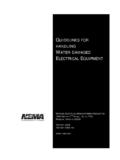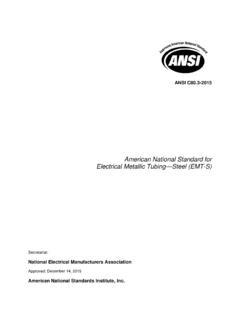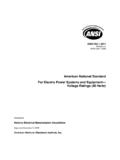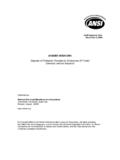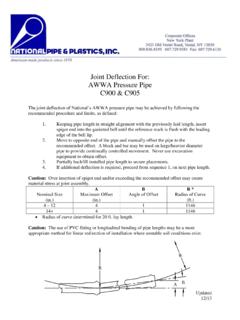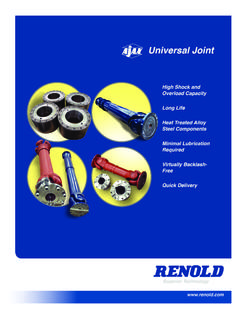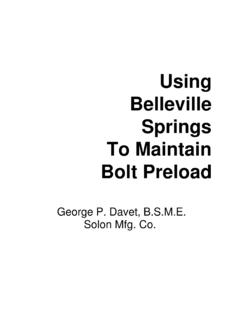Transcription of TECHNICAL SERVICES DEPARTMENT - NEMA
1 TECHNICAL SERVICES DEPARTMENT BULLETIN No. 108 Dec. 12, 2014 (Rev. Apr. 17, 2019) Application of Flexible Conduit for Structural Joints Intended for Expansion, Contraction, or deflection The purpose of this bulletin is to provide guidance, pertaining to (H) Structural Joints of the NEC , in determining the type, length, and bend radius of Flexible Conduit products used for structural joints intended for expansion, contraction, or deflection , used in buildings, bridges, parking garages or other structures. The type of Flexible Conduit selected is based on the location of the structural joint and the environmental and physical exposure. Three choices of Flexible Conduit types are available; Flexible Metal Conduit (FMC) that is an unjacketed helically wound, formed, interlocking metal strip conduit, Liquidtight Flexible Metal Conduit (LFMC) that has an outer nonmetallic liquidtight jacket over an inner flexible metal core, and Liquidtight Flexible Nonmetallic Conduit (LFNC) that is completely nonmetallic with or without an outer nonmetallic liquidtight jacket over a flexible nonmetallic core.
2 Information for understanding the details on how these products are constructed and marked, as well as information on special or optional ratings are provided by UL Product Spec which replaces the document previously referred to as the White Book. The minimum radius of bend for Flexible Conduit is prescribed by the NEC , which specifies that the minimum centerline bend radius ( R as shown in Figure 1) not be less than that listed in Table 2 of Chapter 9 of the NEC under the Other Bends column. The following calculation is applied for determining the required overall length of conduit installed in a traveling vertical loop with offset. If there is no travel or offset, T and F in Figure 1 are equal to zero, respectively.
3 It should be noted that these lengths do not include the length of fittings, as different types of fittings vary in length. L=(8 x TS)+( x A)+ T2+F Where: L = Overall length of conduit TS = Trade size diameter A = Horizontal distance between fittings* T = Travel distance F = Offset Suggested straight length for each end = 4 x Trade Size diameter * Must be greater or equal to 2x the minimum bending radius from NEC Chapter 9, Table 2 Figure 1 DETERMINATION OF OVERALL LENGTH OF CONDUIT INSTALLED IN A TRAVELING VERTICAL LOOP WITH OFFSET R Overall lengths for installations of FMC, LFMC and LFNC having lateral offset O , as shown in Figure 2 are presented in Tables 1 through 10. Figure 2 STRAIGHT LENGTH With reference to Figures 1 and 2, the NEC should be consulted for installation requirements for FMC and LFMC including maximum number of bends and support requirements.
4 STRAIGHT LENGTH STRAIGHT LENGTH B OO Table 1 OVERALL CONDUIT LENGTH FOR GIVEN OFFSET AND LATERAL DISTANCE TRADE SIZE 1/2 Lateral "O" Offset Distance (inches) Distance B (inches) 2 5 6 7 8 9 10 11 12 13 14 15 20 25 30 Table 2 OVERALL CONDUIT LENGTH FOR GIVEN OFFSET AND LATERAL DISTANCE TRADE SIZE 3/4 Lateral "O" Offset Distance (inches) Distance B (inches) 2 7 8 9 10 11 12 13 14 15 20 25 30 Table 3 OVERALL CONDUIT LENGTH FOR GIVEN OFFSET AND LATERAL DISTANCE TRADE SIZE 1 Lateral "O" Offset Distance (inches) Distance B (inches)
5 2 9 10 11 12 13 14 15 20 25 30 Table 4 OVERALL CONDUIT LENGTH FOR GIVEN OFFSET AND LATERAL DISTANCE TRADE SIZE 1 1/4 Lateral "O" Offset Distance (inches) Distance B (inches) 2 11 12 13 14 15 16 17 18 19 20 25 30 Table 5 OVERALL LENGTH OF CONDUIT FOR GIVEN OFFSET AND LATERAL DISTANCE TRADE SIZE 1 1/2 Lateral "O" Offset Distance (inches) Distance B (inches)
6 2 13 14 15 16 17 18 19 20 25 30 Table 6 OVERALL LENGTH OF CONDUIT FOR GIVEN OFFSET AND LATERAL DISTANCE TRADE SIZE 2 Lateral "O" Offset Distance (inches) Distance B (inches) 2 17 18 19 20 22 24 26 28 30 Table 7 OVERALL LENGTH OF CONDUIT FOR GIVEN OFFSET AND LATERAL DISTANCE TRADE SIZE 2 1/2 Lateral "O" Offset Distance (inches) Distance B (inches) 22 24 26 27 28 30 31 32 321.
7 34 36 38 40 Table 8 OVERALL LENGTH OF CONDUIT FOR GIVEN OFFSET AND LATERAL DISTANCE TRADE SIZE 3 Lateral "O" Offset Distance (inches) Distance B (inches) 26 28 30 32 34 36 38 40 42 Table 9 OVERALL LENGTH OF CONDUIT FOR GIVEN OFFSET AND LATERAL DISTANCE TRADE SIZE 3 1/2 Lateral "O" Offset Distance (inches) Distance B (inches) 30 32 34 36 38 40 42 44 46 48 50 Table 10 OVERALL LENGTH OF CONDUIT FOR GIVEN OFFSET AND LATERAL DISTANCE TRADE SIZE 4 Lateral "O" Offset Distance (inches) Distance B (inches) 34 36 38 40 42 44 46 48 50 52 54 Distribution List.
8 Standards and Conformity Assessment Policy Committee Codes and Standards Committee NEMA Operations DEPARTMENT NEC is a registered trademark of the National Fire Protection Association (NFPA) NOTICE AND DISCLAIMER The information in this publication was considered technically sound by the consensus of persons engaged in the development and approval of the document at the time it was developed. Consensus does not necessarily mean that there is unanimous agreement among every person participating in the development of this document. NEMA standards and guideline publications, of which the document contained herein is one, are developed through a voluntary consensus standards development process. This process brings together volunteers and/or seeks out the views of persons who have an interest in the topic covered by this publication.
9 While NEMA administers the process and establishes rules to promote fairness in the development of consensus, it does not write the document and it does not independently test, evaluate, or verify the accuracy or completeness of any information or the soundness of any judgments contained in its standards and guideline publications. NEMA disclaims liability for any personal injury, property, or other damages of any nature whatsoever, whether special, indirect, consequential, or compensatory, directly or indirectly resulting from the publication, use of, application, or reliance on this document. NEMA disclaims and makes no guaranty or warranty, expressed or implied, as to the accuracy or completeness of any information published herein, and disclaims and makes no warranty that the information in this document will fulfill any of your particular purposes or needs.
10 NEMA does not undertake to guarantee the performance of any individual manufacturer or seller s products or SERVICES by virtue of this standard or guide. In publishing and making this document available, NEMA is not undertaking to render professional or other SERVICES for or on behalf of any person or entity, nor is NEMA undertaking to perform any duty owed by any person or entity to someone else. Anyone using this document should rely on his or her own independent judgment or, as appropriate, seek the advice of a competent professional in determining the exercise of reasonable care in any given circumstances. Information and other standards on the topic covered by this publication may be available from other sources, which the user may wish to consult for additional views or information not covered by this publication.

